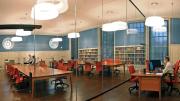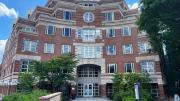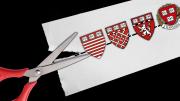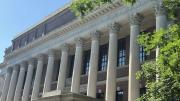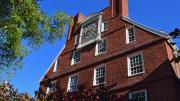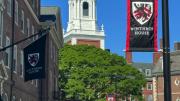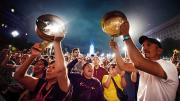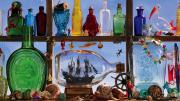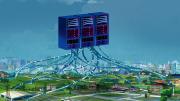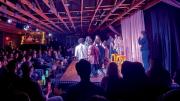Setting the stage. During the 17 pandemic months, Harvard’s grounds crew kept the largely untrod campus looking lovelier than ever. One significant upgrade: the new entry to Houghton Library, whose accessibility features are splendidly beautified with a forest of witch hazels, dwarf fothergillas, clethras, sumacs and more, underplanted with a carpet of sky-blue-blooming plumbago against a backdrop of cheery anemones. The building is framed vertically with impressive specimen parrotias, which promise glowing fall colors, and Hinoki cypresses. The paths come off as garden walkways, rather than ramps with railings: deft work by landscape designer Michael Van Valkenburgh (profiled in “The Urban Landscaper,” November-December 2013, page 32) and colleagues.
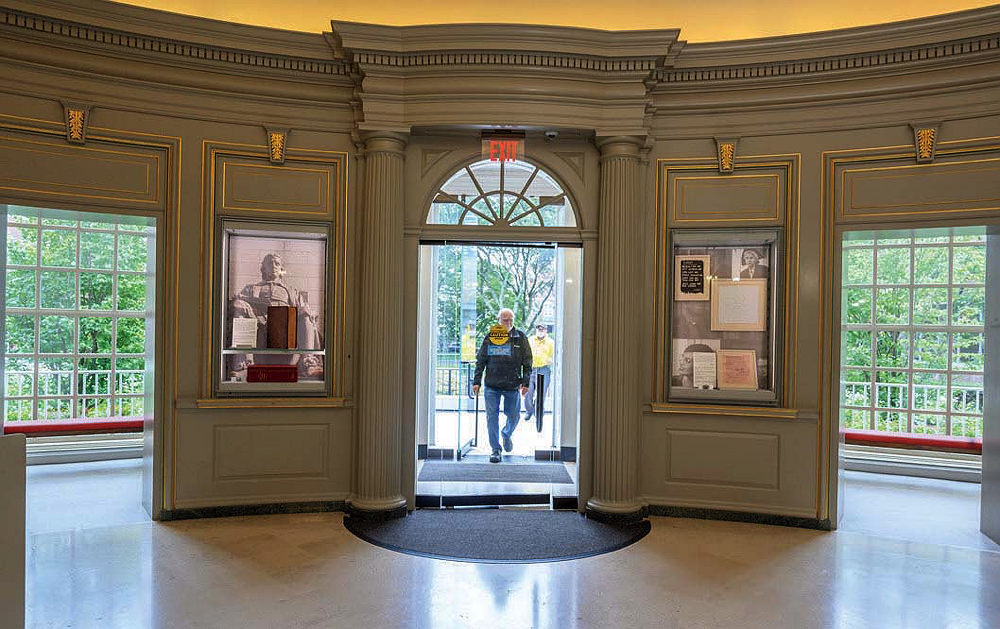
The newly renovated Houghton Library features a redesigned lobby, and improved accessibility features inside and out.
Photograph by Jim Harrison
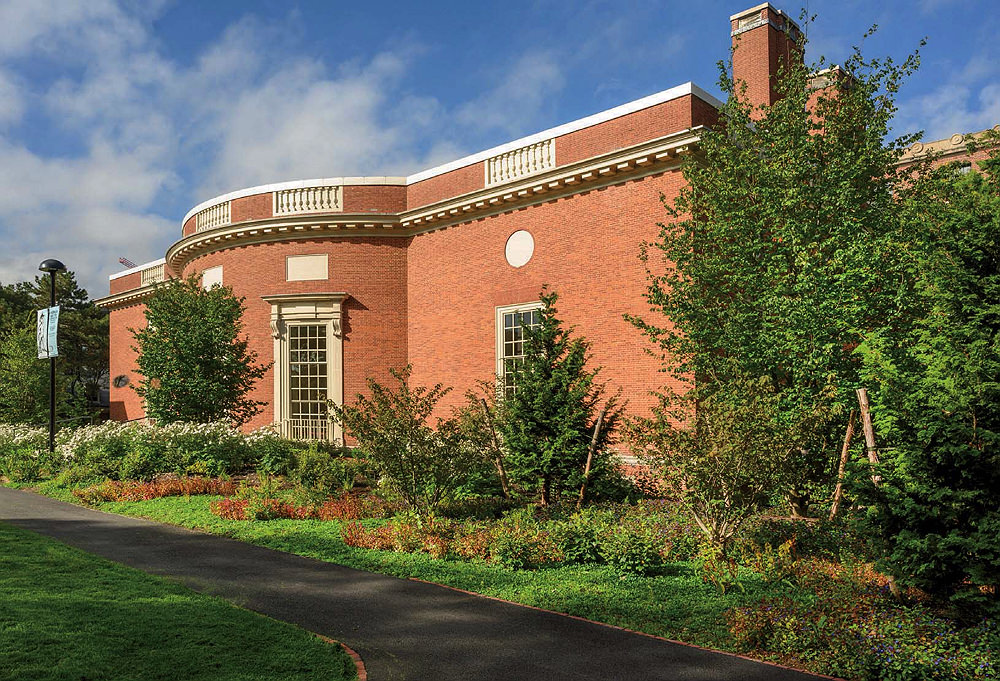
Houghton's redesigned exterior features a lushly landscaped, fully accessible entrance with ramped walkways.
Photograph by Jim Harrison
One sad subtraction, across Quincy Street: the magnificent locust between Dana-Palmer House and Barker Center—with its deeply incised bark—split and had to be put down; its juvenile replacement will look the part several decades hence.
On the venerable buildings front, Wadsworth House sports new cedar roof shingles, and Memorial Hall, up high, the rest of its new shingles (completing a multiyear project): the polychrome slates should be good for the next century and a half. The Divinity School has completed the transformation of Andover into the updated Swartz Hall, and the Law School’s Lewis International Law Center, made taller and with a new glass skin, looks its new self (although work continues). The five-year-plus renovation of Soldiers Field Park, the housing complex alongside Harvard Business School, concluded, presumably giving tenants interior views comparable in quality to their exterior ones over the Charles, Cambridge, and the Boston skyline.
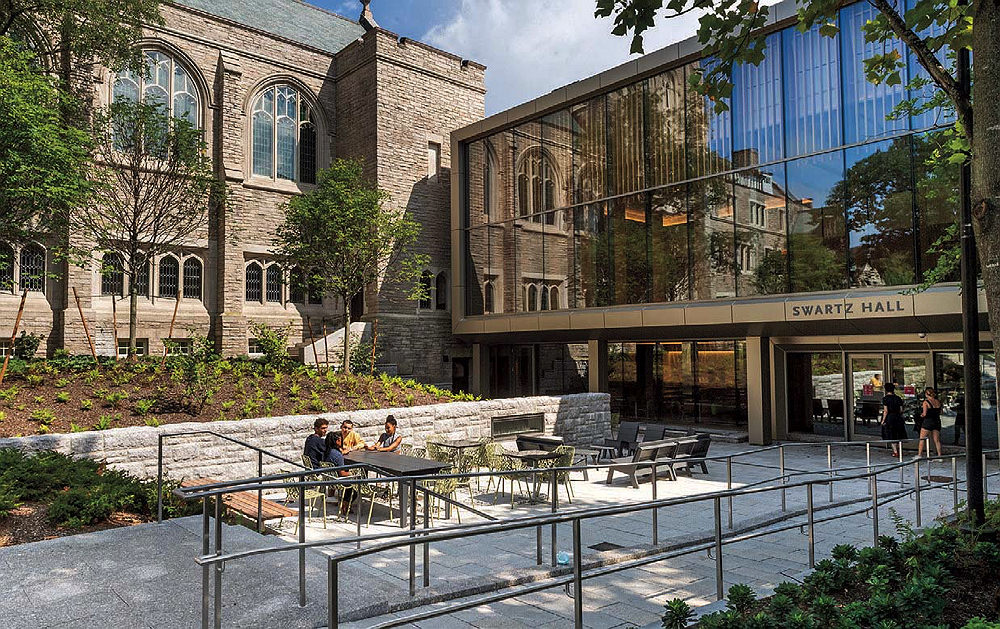
The Divinity School's improved and expanded Swartz Hall
Photograph by Justin Knight/Courtesy of Harvard Divinity School
But visiting all this has become more difficult than ever. Driving into Harvard Square has never been a peak experience—but the obstacles are more formidable now, as Cambridge added a multitude of bicycle lanes and extended restaurant seating into streets. Be warned.
Repeopling the campus. Beyond the traffic challenges, parents and arriving upperclass students had to navigate the Hurricane/Tropical Storm Henri-threatened weekend of August 21-22, but most merely got dampened. Come August 25, when the extra-large cohort of first-year students (’24 deferees plus the regular members of ’25) and their proud families began a spread-out schedule of moving in, it was a sight for sore eyes to see a minivan from Colorado, an SUV from Texas with a U-Haul trailer, and plain old sedans from Florida, Maryland, and Ontario happily laden with stuff. They were met by upperclassmen and -women in Crimson Harvard Move-In T-shirts, on duty to help schlep the gear up into the students’ new homes—finally. There were even Harvard Mom and Harvard Grandma shirts: superb swag. (For more on move-in, see harvardmag.com/25-move-in-21.)
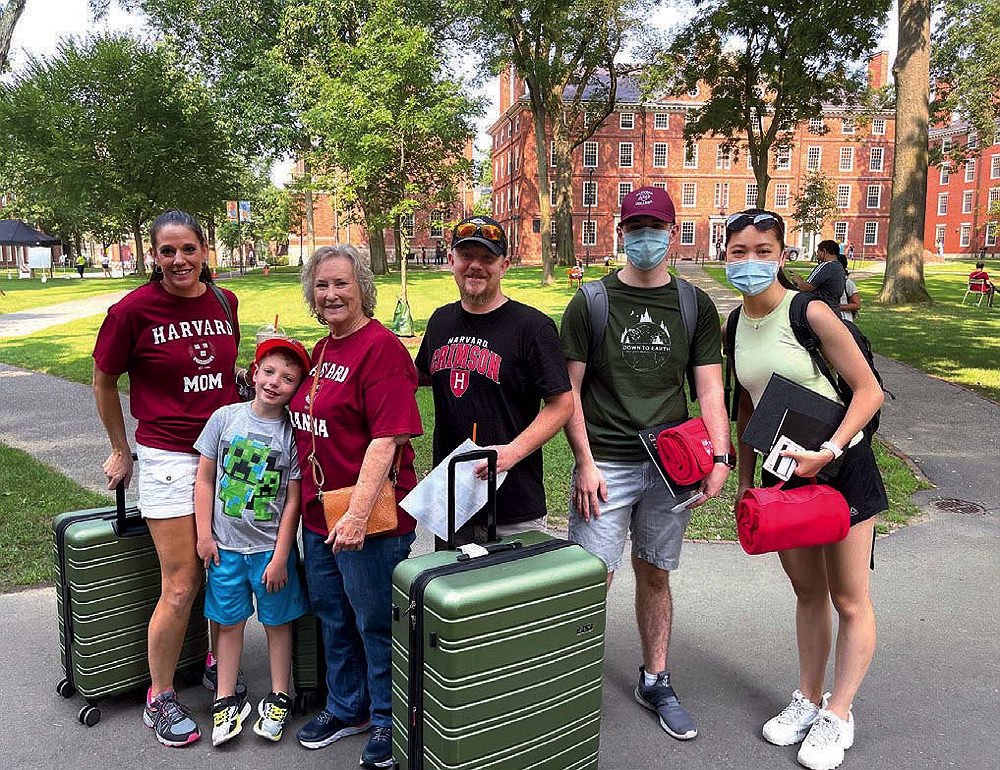
Move-in swag for Gavin Lindsey's family
Photograph by Kristina DeMichele/Harvard Magzine
Not everything was status-quo-ante: the familiar Dunkin’ Donuts goodies and juice were not on offer at entryways this year, indoor-masking mandates and virus-testing protocols were spelled out, and by 5:00 p.m., entry to the Yard was restricted to Harvard ID-holders (a social-distancing precaution maintained overnight through October 11). But no matter: Given the procession of plagues—the pandemic; the near-hurricane (and then the drenching delivered by the successor Hurricane Ida on the first day of classes); the brood of locusts (okay, cicadas) earlier in the summer in states to the south; and the forest fires out west—the local near-normalcy seemed downright miraculous.
The College hosted two convocations on August 30: an in-person successor to the online version for the class of 2024 last year, and then the class of 2025’s in the traditional way. The latter, still students-to-be, heard a plea from Harvard College dean Rakesh Khurana to really listen to one another “with intention and humility.” President Lawrence S. Bacow drew on the Talmud to reinforce that plea (a wise person, he quoted, is “The person who learns from all people”) and others. In his other opening messages, to the community and during Morning Prayers in Memorial Church on September 1, the president asked the community to be its best self: “treat[ing] others with respect and kindness,” in a world ever more polarized and riven, and taking care to act responsibly to ensure everyone’s health. (Reports on the ceremonies and remarks may be found at harvardmag.com/24-25-convocation-21 and harvardmag.com/humbling-prayers-21.)
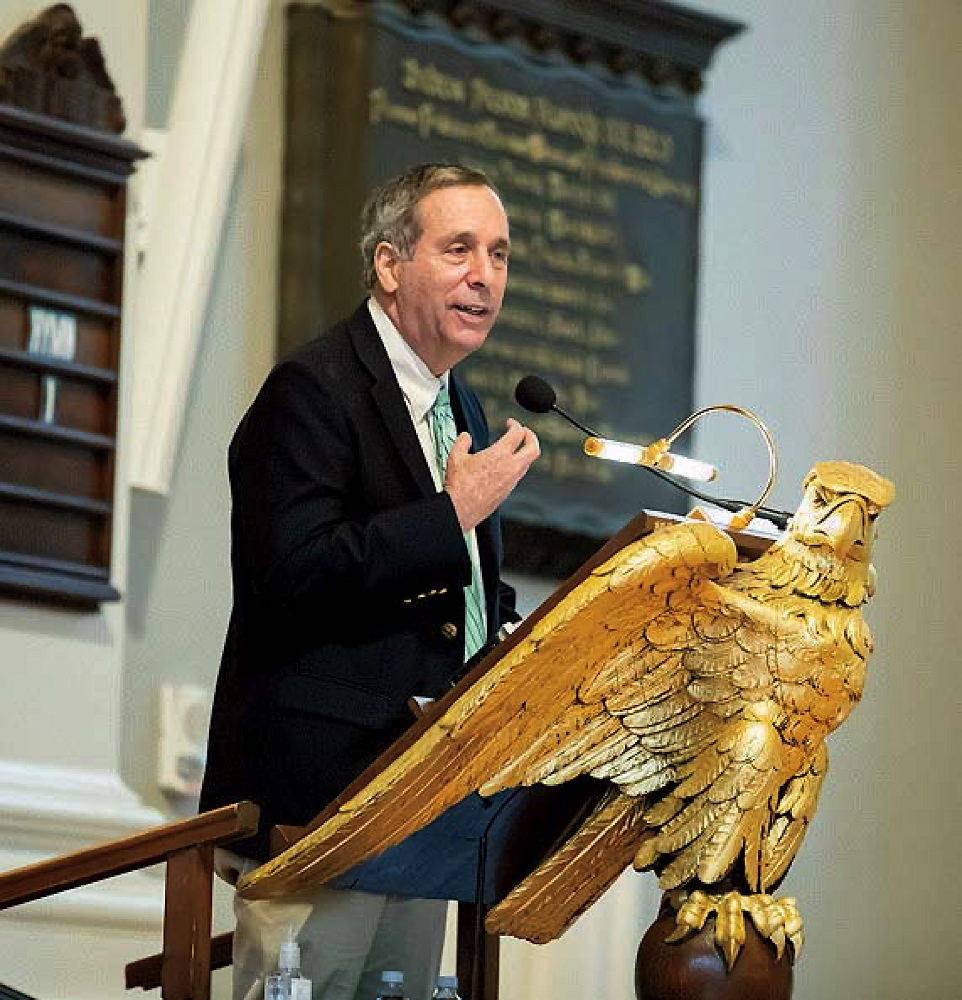
President Bacow on "respect and kindness" at Morning Prayers
Photograph by Rose Lincoln/HPAC
Emerging from the church, one was greeted with the uncannily ordinary sight of students strolling and scootering across Tercentenary Theatre, off to their first classes of the semester. The Harvard Art Museums, closed since March 2020, reopened to students that day (and to the public September 4). And The Harvard Crimson, online only since that same March 13, resumed publication in print, too, with an exuberant “Campus Comes Back to Life” banner headline. Within days, the Yard’s venerable turf in front of Matthews Hall was yet again dug up in service of Anthropology 1130, “The Archaeology of Harvard Yard”: the latest iteration of the course, in search of clay pipes, lead musket balls, brick bits, and other fragments from an earlier era—when the vaccine controversies centered on cow- and smallpox (see “A Box of Pox,” May-June 2003, page 84).
Causes for concern. For all the appearances of normalcy, the reasons for all the precautions soon became apparent. “Delta,” after all, carries dual meanings: the current name of a highly contagious coronavirus variant, and the Greek letter signifying “change” in equations. The variant altered campus routines, swiftly.
On September 2, Bacow told the Harvard Gazette, “The only thing I can say with certainty is that all plans are subject to change.” That same day—the second day of classes—Giang T. Nguyen, executive director of Harvard University Health Services, disseminated a community message titled, “Increase in COVID-19 Cases, Take Steps to Protect Yourself & Our Community.” Despite remarkable vaccination rates (95 percent for employees, 93 percent for students), he wrote, 94 new infections had been identified by the University’s extensive, high-speed testing regimen just during the prior week. Accordingly, the “testing cadence” for everyone living in undergraduate housing (students, advisers, etc.) was tripled to three times weekly—and all were advised, among other measures, to keep the number of people less than 6 feet away “as low as possible,” to minimize events that involve eating or drinking, and to consider dining “consistently with the same small group” of two to four tablemates.
Another change put in motion was the reversal of efforts, effective only as of August 2, to bring most nonacademic employees back to work. By September 2, staff members in “non-student-facing roles” who had recently ventured back to campus were asked to resume working remotely, while those who had not returned to work learned they would delay doing so until further notice. (This move helped assure that the amped-up testing of those 7,000 or so people in undergraduate housing, plus contact tracing and quarantine or isolation where warranted, could be done effectively.)
Adapting on the fly. And so it went. The Friday night Crimson Jam concert and block party, a year-opening College social event, scheduled for September 3, was postponed indefinitely. On September 7, one weekend into its (reduced-capacity, advanced-reservation, masked) reopening, the Harvard Art Museums announced that as of September 28, visitors would have to provide proof of vaccination or a recent negative coronavirus test before gaining entry.
Reflecting longer-term, pandemic-wrought changes in Harvard’s operations, faculty and staff members and researchers were advised that those working more than 20 percent of the time out of state had to alter their status in the payroll system so that appropriate taxes could be withheld: a new definition of what it means to be part of the community.
The College’s weekly update of September 9 cheerily counseled undergraduates on “maintaining academic continuity in isolation” (a state in which 137 community members then found themselves). Because such students cannot attend classes, they were advised to “identify a ‘study buddy’” who could provide class notes, and to explore Zoom options. The next day, a Friday, Nguyen weighed in again. He noted that University contact-tracing “has not indicated any evidence of transmission within our classrooms,” and reminded everyone to consider the needs of high-risk members of the community or those whose households contain people at risk. He urged continued masking; “quick sip” procedures for taking a drink (“If you wish to slowly savor a hot beverage, do it away from others”); and “consume and cover!” dining. No doubt with undergraduates in mind, heading into beautiful early-autumn days off, he issued a six-point admonition to “socialize thoughtfully”—with emphasis added: “This includes on weekends,” for which he counseled “creative” events that “don’t involve eating, drinking, or removal of masks….”
The unknowns. Cautious though Harvard administrators had been, from early closing in March 2020 through gradual reopening, the University—informed by world-class faculty scientists—was still very much engaged in a cat-and-mouse game with the wily virus. A spike in cases among first-year M.B.A. candidates at Harvard Business School forced many classes online for the week beginning September 27—and a tripling of viral testing for that student body, too. The Faculty of Arts and Sciences retained the Zoom format for its fall-term meetings, beginning October 5. Tents on lawns throughout the Yard accommodated outdoor classes and socializing. And the huge tent on the Science Center plaza, near Annenberg, encouraged undergraduates to dine outside as well.
Containing the pandemic locally before autumn settled in (bringing cooler temperatures and shorter days, driving everyone indoors and closer together) would be essential to operating this academic institution in person, as it had been unable to do for many prior months. Students and their professors, enlivened by being in classrooms together again, all had stakes in remaining vigilant during this new round in a continuing struggle.
